Intel Core i7 4960X (Ivy Bridge E) Review
by Anand Lal Shimpi on September 3, 2013 4:10 AM EST- Posted in
- CPUs
- Intel
- Ivy Bridge
- Ivy Bridge-E
Gaming Performance
Chances are that any gamer looking at an IVB-E system is also considering a pretty ridiculous GPU setup. NVIDIA sent along a pair of GeForce GTX Titan GPUs, totalling over 14 billion GPU transistors, to pair with the 4960X to help evaluate its gaming performance. I ran the pair through a bunch of games, all at 1080p and at relatively high settings. In some cases you'll see very obvious GPU limitations, while in other situations we'll see some separation between the CPUs.
I haven't yet integrated this data into Bench, so you'll see a different selection of CPUs here than we've used elsewhere. All of the primary candidates are well represented here. There's Ivy Bridge E and Sandy Bridge E of course, in addition to mainstread IVB/SNB. I threw in Gulftown and Nehalem based parts, as well as AMD's latest Vishera SKUs and an old 6-core Phentom II X6.
Bioshock Infinite
Bioshock Infinite is Irrational Games’ latest entry in the Bioshock franchise. Though it’s based on Unreal Engine 3 – making it our obligatory UE3 game – Irrational had added a number of effects that make the game rather GPU-intensive on its highest settings. As an added bonus it includes a built-in benchmark composed of several scenes, a rarity for UE3 engine games, so we can easily get a good representation of what Bioshock’s performance is like.
We're running the benchmark mode at its highest quality defaults (Ultra DX11) with DDOF enabled.
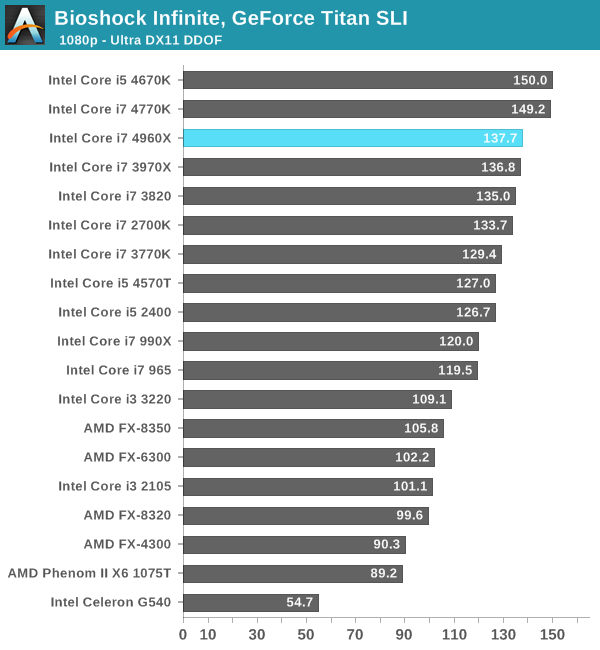
We're going to see a lot of this I suspect. Whenever we see CPU dependency in games, it tends to manifest as being very dependent on single threaded performance. Here Haswell's architectural advantages are appearent as the two quad-core Haswell parts pull ahead of the 4960X by about 8%. The 4960X does reasonably well but you don't really want to spend $1000 on a CPU just for it to come in 3rd I suppose. With two GPUs, the PCIe lane advantage isn't good for much.
Metro: Last Light
Metro: Last Light is the latest entry in the Metro series of post-apocalyptic shooters by developer 4A Games. Like its processor, Last Light is a game that sets a high bar for visual quality, and at its highest settings an equally high bar for system requirements thanks to its advanced lighting system. We run Metro: LL at its highest quality settings, tesselation set to very high and with 16X AF/SSAA enabled.
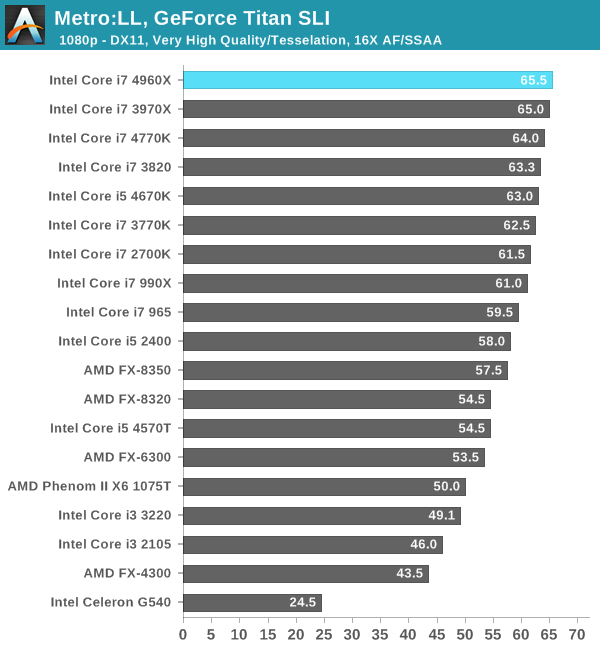
The tune shifts a bit with Metro: LL. Here the 4960X actually pulls ahead by a very small amount. In fact, both of the LGA-2011 6-core parts manage very small leads over Haswell here. The differences are small enough to basically be within the margin of error for this benchmark though.
Sleeping Dogs
A Square Enix game, Sleeping Dogs is one of the few open world games to be released with any kind of benchmark, giving us a unique opportunity to benchmark an open world game. Like most console ports, Sleeping Dogs’ base assets are not extremely demanding, but it makes up for it with its interesting anti-aliasing implementation, a mix of FXAA and SSAA that at its highest settings does an impeccable job of removing jaggies. However by effectively rendering the game world multiple times over, it can also require a very powerful video card to drive these high AA modes.
Our test here is run at the game's Extreme Quality defaults.
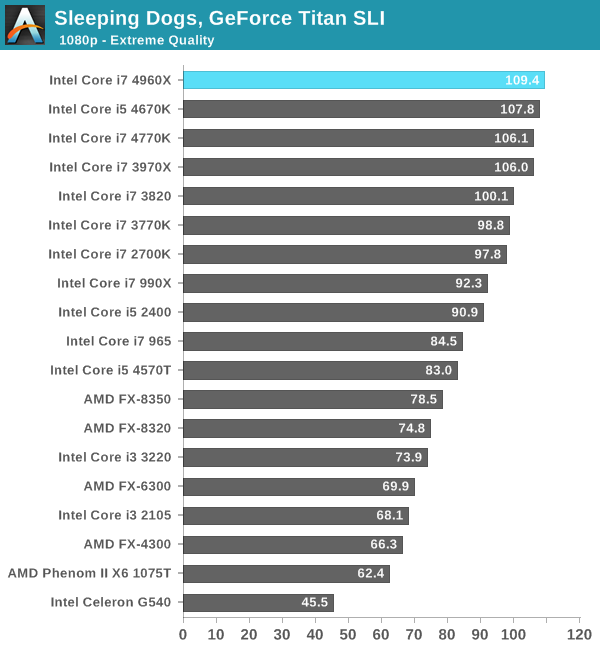
Sleeping Dogs shows similar behavior of the 4960X making its way to the very top, with Haswell hot on its heels.
Tomb Raider (2013)
The simply titled Tomb Raider is the latest entry in the Tomb Raider franchise, making a clean break from past titles in plot, gameplay, and technology. Tomb Raider games have traditionally been technical marvels and the 2013 iteration is no different. Like all of the other titles here, we ran Tomb Raider at its highest quality (Ultimate) settings. Motion Blur and Screen Effects options were both checked.
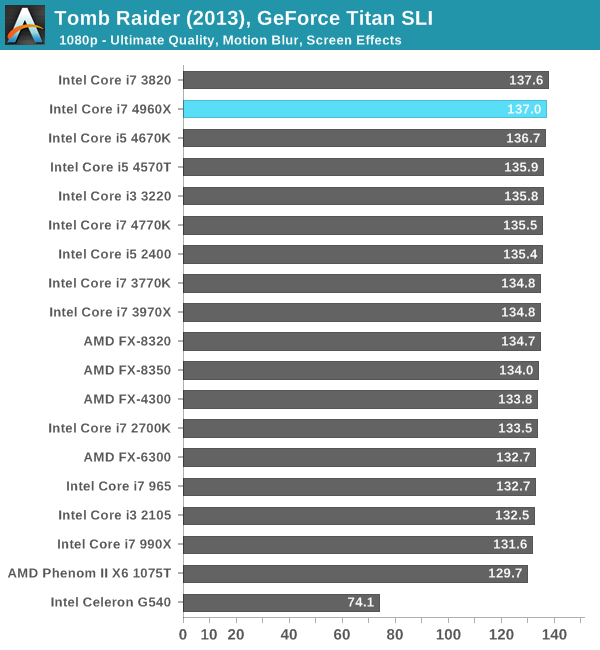
With the exception of the Celeron G540, nearly all of the parts here perform the same. The G540 doesn't do well in any of our tests, I confirmed SLI was operational in all cases but its performance was just abysmal regardless.
Total War: Shogun 2
Our next benchmark is Shogun 2, which is a continuing favorite to our benchmark suite. Total War: Shogun 2 is the latest installment of the long-running Total War series of turn based strategy games, and alongside Civilization V is notable for just how many units it can put on a screen at once. Even 2 years after its release it’s still a very punishing game at its highest settings due to the amount of shading and memory those units require.
We ran Shogun 2 in its DX11 High Quality benchmark mode.
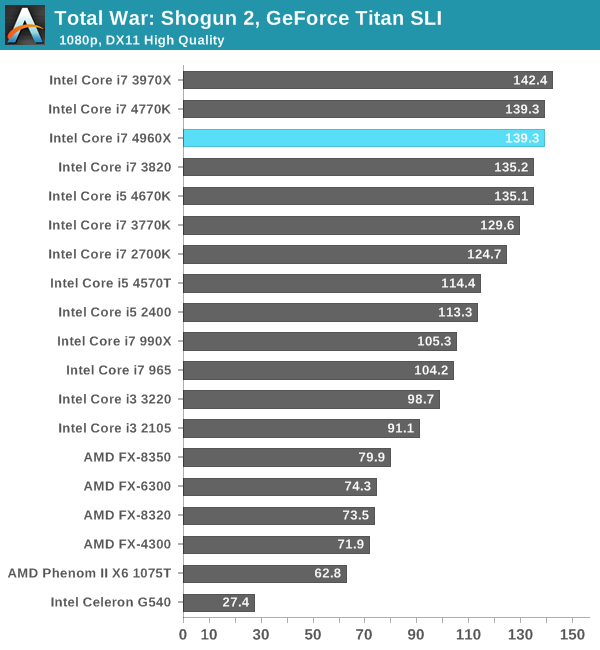
We see roughly equal performance between IVB-E and Haswell here.
GRID 2
GRID 2 is a new addition to our suite and our new racing game of choice, being the very latest racing game out of genre specialty developer Codemasters. Intel did a lot of publicized work with the developer on this title creating a high performance implementation of Order Independent Transparency for Haswell, so I expect it to be well optimized for Intel architectures.
We ran GRID 2 at Ultra quality defaults.
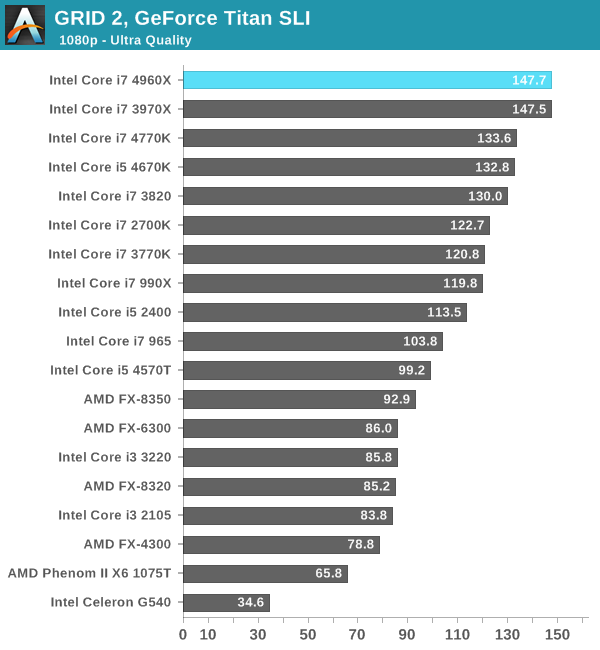
We started with a scenario where Haswell beat out IVB-E, and we're ending with the exact opposite. Here the 10% advantage is likely due to the much larger L3 cache present on both IVB-E and SNB-E. Overall you'll get great gaming performance out of the 4960X, but even with two Titans at its disposal you won't see substantially better frame rates than a 4770K in most cases.










120 Comments
View All Comments
wsaenotsock - Tuesday, September 3, 2013 - link
How does Intel's closed-loop cooling package compare to say, Corsair's or other similar products?chizow - Tuesday, September 3, 2013 - link
Probably within 1-2C of similar "extra wide" 120x37mm closed-loop coolers. Looks like Intel's solution is made by Asetek going by it's block and mounting design, so I'd compare it against the Antec 920 for starters.Samus - Tuesday, September 3, 2013 - link
Still running i7-950 system (was an i7-920 back in 2008) and all I've upgraded since building it is a small bump in CPU speed, added water cooling, and installed two GTX660's in place of two GTX460's installed in 2010, which replaced the Radeon 4870x2 from the original 2008 assembly date. I've also replaced the original 500GB Seagate Boot Drive from 2008 with an Intel 160GB X25-M in 2010. Still use the same SSD to this day.Same motherboard, same 6x2GB G.skill DDR3-1600 modules (that cost $600 back in 2008) and same PC Power & Cooling 750-QUAD.
I've added a USB 3.0 PCIe controller as well.
Overall, this is the longest (5 years) I've ever owned a system that retained the same motherboard. The irony is Intel discontinued Socket 1366 so fast it wasn't even funny. It was actively supported less than 2 years, and only 2 generations of chips (using the same architecture and process) were made within a year of each other, essentially giving this socket a 15-month lifetime.
But 5 years later, a system built on this socket is still faster than 90% of the production systems today.
Assimilator87 - Tuesday, September 3, 2013 - link
Yeah, for 1366 owners, there's absolutely no reason to upgrade, especially with overclocking. At least you got one generation of upgrades, unlike 1156 owners who got completely screwed.P.S. The second gen upgrade on 1366 (Westmere) was a new architecture and process. They shrunk down from 45nm to 32nm and added AES instructions.
Inso-ThinkTank - Sunday, January 19, 2014 - link
I'm a current 1156 socket owner running I7 875K @ 4.2. My rig is still running strong, but I'm ready for an upgrade. Just purchase a 4960x with 16 gig of Corsair Dominator Platinum at 2400 and the Asus Black Edition mobo. Hope the spending is worth it.evilspoons - Tuesday, September 3, 2013 - link
What does this have to do with chizow's comment about the closed-loop cooler??JPForums - Thursday, September 5, 2013 - link
Absolutely nothing. I'm guessing it was just an easy way to get posted near the top.
If I recall correctly, the 920 is 49mm thick. Also, I've found that fan selection can make more than a little difference. I would not expect the Intel cooler to match Antec's 920, given their history of racing to the bottom with cooler components. That said, it should beat the 620 and similar 120x120x25mm closed loop systems (assuming they didn't screw up the fan selection in epic manner).
foursixty - Saturday, April 5, 2014 - link
I run a i7950 at 4.07 ghz with a overclocking thermaltake cooler, 3x 580's and 12 gb ddr, am now upgrading to the i74960x, thermaltake water 3.0 and 2 x asus gtx 780ti sli, 32 gb ddr3. the old rig is still going strong and will use it for a simulator pc as i have a g27 sitting doing nothing. Great machine and has served me well!~foursixty - Saturday, April 5, 2014 - link
just might add for the asus sabertooth x79, i74960x, 32gb 2400 ddr3, and 2 asus gtx 780ti oc cards is a $4000 upgrade, been doing a lot of overtime so i thought i would update while i got the extra cashjust4U - Friday, September 6, 2013 - link
Corsairs closed loop and Intel's appear to be built by the same company.. Some of Corsair's earlier attempts were noisy whereas you didn't really have that problem with Intel's. Overall I think it's a pretty solid contender with very few faults. There is better on the market obviously... but it's decent for it's price.